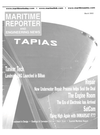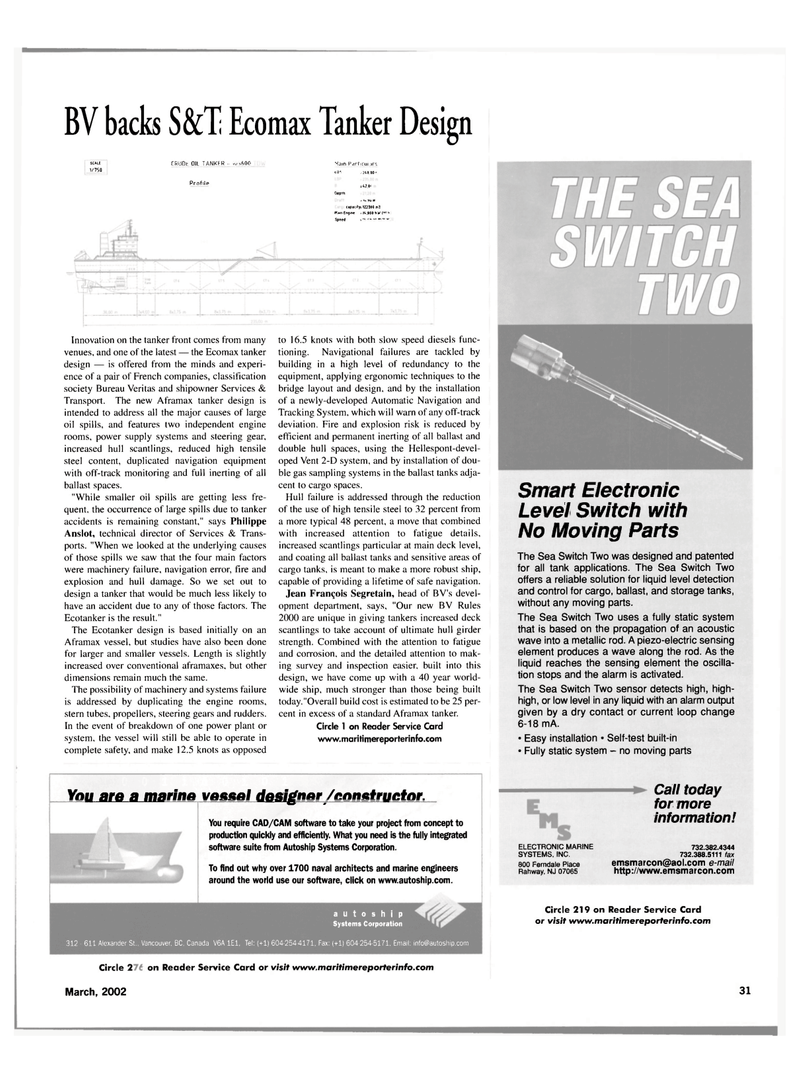
Page 31: of Maritime Reporter Magazine (March 2002)
Read this page in Pdf, Flash or Html5 edition of March 2002 Maritime Reporter Magazine
BY backs S&T Ecomax Tanker Design
SCAli
VI53 MUOt OIL TANKER - I 0 •
Profile ' I isn ; <>,y \!Cu;./ . i ' . i'ig so - = 41,01
Deprh : ' . IT ttpaoftp !2230G m3 r." , engine U.BB5KW " •
Spnrd ' • '
Innovation on the tanker front comes from many venues, and one of the latest — the Ecomax tanker design — is offered from the minds and experi- ence of a pair of French companies, classification society Bureau Veritas and shipowner Services &
Transport. The new Aframax tanker design is intended to address all the major causes of large oil spills, and features two independent engine rooms, power supply systems and steering gear, increased hull scantlings, reduced high tensile steel content, duplicated navigation equipment with off-track monitoring and full inerting of all ballast spaces. "While smaller oil spills are getting less fre- quent. the occurrence of large spills due to tanker accidents is remaining constant," says Philippe
Anslot, technical director of Services & Trans- ports. "When we looked at the underlying causes of those spills we saw that the four main factors were machinery failure, navigation error, fire and explosion and hull damage. So we set out to design a tanker that would be much less likely to have an accident due to any of those factors. The
Ecotanker is the result."
The Ecotanker design is based initially on an
Aframax vessel, but studies have also been done for larger and smaller vessels. Length is slightly increased over conventional aframaxes, but other dimensions remain much the same.
The possibility of machinery and systems failure is addressed by duplicating the engine rooms, stern tubes, propellers, steering gears and rudders.
In the event of breakdown of one power plant or system, the vessel will still be able to operate in complete safety, and make 12.5 knots as opposed to 16.5 knots with both slow speed diesels func- tioning. Navigational failures are tackled by building in a high level of redundancy to the equipment, applying ergonomic techniques to the bridge layout and design, and by the installation of a newly-developed Automatic Navigation and
Tracking System, which will warn of any off-track deviation. Fire and explosion risk is reduced by efficient and permanent inerting of all ballast and double hull spaces, using the Hellespont-devel- oped Vent 2-D system, and by installation of dou- ble gas sampling systems in the ballast tanks adja- cent to cargo spaces.
Hull failure is addressed through the reduction of the use of high tensile steel to 32 percent from a more typical 48 percent, a move that combined with increased attention to fatigue details, increased scantlings particular at main deck level, and coating all ballast tanks and sensitive areas of cargo tanks, is meant to make a more robust ship, capable of providing a lifetime of safe navigation.
Jean Francois Segretain, head of BV's devel- opment department, says, "Our new BV Rules 2000 are unique in giving tankers increased deck scantlings to take account of ultimate hull girder strength. Combined with the attention to fatigue and corrosion, and the detailed attention to mak- ing survey and inspection easier, built into this design, we have come up with a 40 year world- wide ship, much stronger than those being built today."Overall build cost is estimated to be 25 per- cent in excess of a standard Aframax tanker.
Circle 1 on Reader Service Card www.maritimereporterinfo.com
Smart Electronic
Level Switch with
No Moving Parts
The Sea Switch Two was designed and patented for all tank applications. The Sea Switch Two offers a reliable solution for liquid level detection and control for cargo, ballast, and storage tanks, without any moving parts.
The Sea Switch Two uses a fully static system that is based on the propagation of an acoustic wave into a metallic rod. A piezo-electric sensing element produces a wave along the rod. As the liquid reaches the sensing element the oscilla- tion stops and the alarm is activated.
The Sea Switch Two sensor detects high, high- high, or low level in any liquid with an alarm output given by a dry contact or current loop change 6-18 mA. • Easy installation • Self-test built-in • Fully static system - no moving parts
You are a marine vessel designer/constructor.
You require CAD/CAM software to take your project from concept to production quickly and efficiently. What you need is the fully integrated software suite from Autoship Systems Corporation.
To find out why over 1700 naval architects and marine engineers around the world use our software, click on www.autoship.com. autoship
Systems Corporation
ELECTRONIC MARINE
SYSTEMS. INC. 800 Ferndale Place
Rahway, NJ 07065
Call today for more information! 732.382.4344 732.388.5111 fax [email protected] e-mail http://www.emsmarcon.com
Circle 219 on Reader Service Card or visit www.maritimereporterinfo.com 312 - 611 Alexander St.. Vancouver, BC, Canada V6A 1E1, Tel: (+1) 604-254-4171, Fax: (+1) 604-254-5171, Email: [email protected]
Circle 254 on Reader Service Card or visit www.maritimereporterinfo.com
March, 2002 31

 30
30

 32
32
